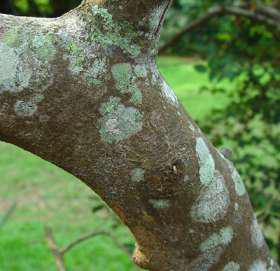Cryptocarya wyliei
Cryptocarya wyliei Stapf
Family: Lauraceae
Common names: red quince; red-haired laurel (Eng.); rooikweper (Afr.); umNgcabe (Zulu); umNqayane (Zulu, Xhosa)
SA Tree No: 117
Introduction
Cryptocarya wyliei is a beautiful ornamental tree, easily grown from seed, with bright red edible fruit scattered among the tiny green leaves.

Description
Description
Cryptocarya wyliei is a shrub or a small tree ranging from 2 to 6 m high in evergreen forests along the coast. The main stem is greyish and the branch tips and leaf buds are covered with coppery hairs. The leaves are small, green on the upper surface, the under surface silvery blue with rust-coloured/coppery hairs along the midrib and veins; a relatively broad base that tapers towards the tips as the margin rolls under.
The plant flowers between December and April, with small white flowers covered with coppery hairs. The flowers eventually develop into bright red fruit, ripening between February and April.

Distribution and habitat
Distribution description
This plant is confined to Natal Group Sandstones, with a scattered distribution in forests of the former Transkei and the KwaZulu-Natal areas. It is also abundant in coastal bush, forest margins, as well as riverine fringe forest and thicket.
Derivation of name and historical aspects
History
The word Cryptocarya stems from the Greek word krypto meaning hidden and carya which means nut, as the ripened fruit is hidden in the enlarged part of the calyx. The species of this genus differ quite significantly from each other in appearance. As the name suggests, they are difficult to spot, seeing that they appear to resemble every other tree that one could possibly find in a tropical forest. Nevertheless, once the tree has been identified as a Cryptocarya, determining the species is relatively easy, at least in Africa.
The species name wyliei was named in honour of James Wylie (1861-1947) who was first appointed in the Durban Botanical Garden as a gardener and later on became the second curator of the Garden, after Medley Wood.
The genus has ± 350 species, with seven southern African representatives. The family Lauraceae is one of the oldest groups of flowering plants, and has been a feature of tropical forests for well over 100 million years. So it comes as no surprise to find that members of this family supply such delightful and useful things as avocado pears, bay-laurel, cinnamon, camphor, imbuia and stinkwood. Unfortunately, the family also includes notably unpleasant plants such as Litsea glutinosa (Indian laurel), which is a serious invader on the KwaZulu-Natal coast, and the dodder-like parasite Cassytha.
Uses
Use
Cryptocarya wyliei, along with the other southern African members of the genus, is used as a substitute for Ocotea bullata in traditional practices, for both medicinal and magical purposes. Concoctions and infusions of the bark are often used to treat headaches, urinary disorders, stomach complications, as well as emotional and nervous disorders. It is also said to be an effective remedy for treating infantile diarrhoea.

Growing Cryptocarya wyliei
Grow
The red-haired laurel makes a decorative understorey for a forest garden, and would be seen to advantage together with any of the Trichocladus (witch-hazel) species in a corner dominated by some of our really large forest trees such as Inhambanella henriquesii (milk plum) and the larger Umdoni (Syzygium species). The undergrowth under these two layers of trees will be an ideal place for shade-loving forest plants such as clivias, many ferns, peperomias and many species of Plectranthus. A garden corner set up like this will occupy a vast amount of space (the canopy trees are not only tall, but spread a long way sideways) and will consume significant quantities of water, but will be a refuge for plants and animals — including humans — that love the forests which used to clothe our eastern seaboard.
This plant can be grown from seed and cuttings. Remove the seeds from the fleshy pulp of the ripe fruit. Sow the cleaned seeds in a sandy loam soil mix in a seed tray and cover with pieces of bark. Store the tray in a warm, moist place. This should ensure germination in about four to six weeks.
Cryptocarya can also be grown from cuttings in summer. This can be done by dipping the cutting in a rooting hormone mixture to promote rooting. Thereafter, place the cutting in a bark and polystyrene mix.
References
- Coates Palgrave, K. 1983. Trees of southern Africa, e dn 2. Struik, Cape Town.
- Glen, H.F. 2007. SAPPI tree spotting: whats's in a name? Jacana, Johannesburg.
- Leistner, O.A. (ed.). 2000. Seed plants of southern Africa : families and genera. Strelitzia 10 National Botanical Institute, Pretoria.
- Mabberley, D.J. 1997. The plant-book, edn 2. Cambridge University Press, Cambridge.
- Palmer, E. & Pitman, M. 1972. Trees of southern Africa. Balkema, Cape Town.
- Pooley, E. 1993. A complete field guide to trees of Natal, Zululand and Transkei., Natal Flora Publications Trust, Pietermaritzburg.
- Van Wyk, B-E., Van Oudtshoorn, B. & Gericke, N. 1997. Medicinal plants of South Africa. Briza Publications, Pretoria.
Credits
T. Naidoo & H. F. Glen
Kwazulu-Natal Herbarium
Durban
October 2007
Plant Attributes:
Plant Type: Shrub, Tree
SA Distribution: Eastern Cape, KwaZulu-Natal
Soil type: Sandy, Loam
Flowering season: Early Summer, Late Summer
PH: Acid, Neutral
Flower colour: White
Aspect: Full Sun, Shade, Morning Sun (Semi Shade), Afternoon Sun (Semi Shade)
Gardening skill: Average
Special Features:
Horticultural zones









Rate this article
Article well written and informative
Rate this plant
Is this an interesting plant?
Login to add your Comment
Back to topNot registered yet? Click here to register.